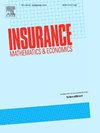定律不变函数的参考测量值是唯一的吗?
IF 1.9
2区 经济学
Q2 ECONOMICS
引用次数: 0
摘要
如果一个定义在随机变量 f 上的函数的值只取决于其参数 f 在参考概率下的分布,那么这个函数在参考概率方面是不变的。与大多数相关文献不同的是,我们将一个具体的函数作为给定值,并询问是否存在不止一个这样的参考概率。对于包括货币风险度量和收益风险度量等在内的各类函数,我们证明除非它们(i)是常数,或(ii)更普遍地只取决于参数 f 的基本下确值和基本上确值,否则情况并非如此。在数学上,这些结果利用了 Lyapunov 的凸性定理。本文章由计算机程序翻译,如有差异,请以英文原文为准。
Are reference measures of law-invariant functionals unique?
A functional defined on random variables f is law invariant with respect to a reference probability if its value only depends on the distribution of its argument f under that measure. In contrast to most of the literature on the topic, we take a concrete functional as given and ask if there can be more than one such reference probability. For wide classes of functionals – including, for instance, monetary risk measures and return risk measures – we demonstrate that this is not the case unless they are (i) constant, or (ii) more generally depend only on the essential infimum and essential supremum of the argument f. Mathematically, the results leverage Lyapunov's Convexity Theorem.
求助全文
通过发布文献求助,成功后即可免费获取论文全文。
去求助
来源期刊

Insurance Mathematics & Economics
管理科学-数学跨学科应用
CiteScore
3.40
自引率
15.80%
发文量
90
审稿时长
17.3 weeks
期刊介绍:
Insurance: Mathematics and Economics publishes leading research spanning all fields of actuarial science research. It appears six times per year and is the largest journal in actuarial science research around the world.
Insurance: Mathematics and Economics is an international academic journal that aims to strengthen the communication between individuals and groups who develop and apply research results in actuarial science. The journal feels a particular obligation to facilitate closer cooperation between those who conduct research in insurance mathematics and quantitative insurance economics, and practicing actuaries who are interested in the implementation of the results. To this purpose, Insurance: Mathematics and Economics publishes high-quality articles of broad international interest, concerned with either the theory of insurance mathematics and quantitative insurance economics or the inventive application of it, including empirical or experimental results. Articles that combine several of these aspects are particularly considered.
 求助内容:
求助内容: 应助结果提醒方式:
应助结果提醒方式:


